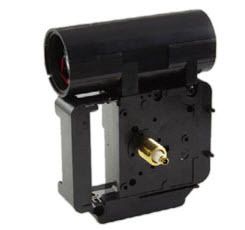Everything about Clock Movements and Motors
 Clock activities and electric motors are the real intestines of timepieces. Clock activities and motors run mechanically or digitally, figuring out at any moment in time the angle subtended by each specific hand. These remarkable devices are our focus in this post.
Clock activities and electric motors are the real intestines of timepieces. Clock activities and motors run mechanically or digitally, figuring out at any moment in time the angle subtended by each specific hand. These remarkable devices are our focus in this post.
Clock motors and also activities are interchangeable terms that describe the very same point, one term maybe preferred by laypersons as well as the other by tradespersons. The earliest ones ran purely mechanically, turning a flywheel based on the force coming from a hanging weight or snugly wound springtime. A pendulum, in tandem with an escapement, acted as the regulator for the standard interval of timing (normally the second).
The modern clock motion is electronic instead of mechanical. Its heart is a quartz crystal that vibrates (resonates) at a precise regularity derived from the crystal geometry. A set of mathematical signs up partitions the natural frequency into proper timekeeping values.
Thus the clock electric motor shows the moment by revolving one spindle (attached to the used) a full turn every minute, another pin (minute hand) a full turn every hr, and a third spindle totally every 12 hours or 24 hours. These hands naturally indicate symbols or figures published on the clock face.
To attain independent turning of all the hands, their particular spindles (or shafts) have to be concentric. Clocks make use of equipments with the number of teeth in carefully calculated ratios to obtain the proper cycles. For this reason, the "seconds" equipment activates a tick of the "minutes" equipment after 60 of its own ticks, as well as in a similar way the "minutes" equipment sets off the "hrs" gear.
Hence fundamental timekeeping is achieved, with the longest cycle being 12 hrs. However, there are various other structures as well as time expansions that make use of 24-hour cycles and even much longer ones than that.
Within these frameworks are variants, in some cases refined, that are incorporated into the movement. For instance, one is usually offered the choice in between second hands that tick audibly as well as those that transform with a silent, continual move. The tick is a carry-over from the custom of pendulum and escapement motion (no more required but usually sought after), while the move used is a typical modern-day choice.
Some clock electric motors feature grand cycles that are monthly or weekly. To execute them requires a fourth hand that points to the date for a 31-day calendar month or to the day of the week. In these instances the chain of activating up the cycle hierarchy is a lot more challenging.
battery operated clock movement
Another thing to consider is whether the clock will immediately adapt to daytime saving time or otherwise. Some motions, particularly those for electronic clocks, could integrate to the atomic clock standard. This conserves having to by hand reset the timepiece as well as stays clear of a semi-permanent mis-synchronization ought to Congress transform the daylight financial savings days.
Some clock motions can showing climate information instead of, or along with, showing the time. Common information are temperature level, barometric pressure, as well as moisture, which are acquired from sensing units instead of calculated according to a cycle. Nevertheless, weather condition activities showing tidal details (i.e., trend degree) track both lunar and solar cycles, and they also incorporate influences based upon neighborhood conditions.
Showing weather data requires a minimum of an added hand or hands, and it might additionally call for specially calibrated dials. To earn tidal screens accurate, one additionally needs to adjust the electric motor itself.
We have actually checked out the main objectives of electric motors; currently we intend to review the additional or additional attributes that they provide. These are either constructed into the gadget itself or are given as attachments with their own buttons.
First off, standard clock activities furnish enough torque to rotate little- or medium-sized hands a full circle. (This suggests that the size of the minute hand, from pivot point to tip, goes to a lot of six inches.) What about large clocks?
As clock hands grow they also obtain heavier. Criterion activities are no longer strong sufficient to transform them. In these cases, the clockmaker ought to seek a high torque model with the same set of attributes as the conventional version.
We now devote a word or 2 about power. Mechanical clocks owned the workings with weights or springtimes, and these of course needed to be reset to their optimal possible energy states occasionally. Nowadays power is the owning pressure, needing power cables linkeded into wall outlets or batteries (e.g., C or AA cells).
Batteries have to be changed every now and then, as well as electricity stops to stream when the power heads out. This is rarely a vital problem, though preserving precise time is important in some situations. A good service is to equip the clock with both a power cord and a battery.
By doing this, one kind of power can take control of when the other is failing. A variation on this style is the uninterruptible power supply (UPS). One more suggestion, especially useful for outdoors, is to use solar clocks the rechargeable batteries for which get juiced through solar power.
To have Westminster (or various other formed) chimes play in the home, consider utilizing chiming clock motions. To have the uniqueness of oscillating pendulums connected to your clocks, order this attribute (as most movements supply it). Which is all there is to know about clock movements as well as motors.